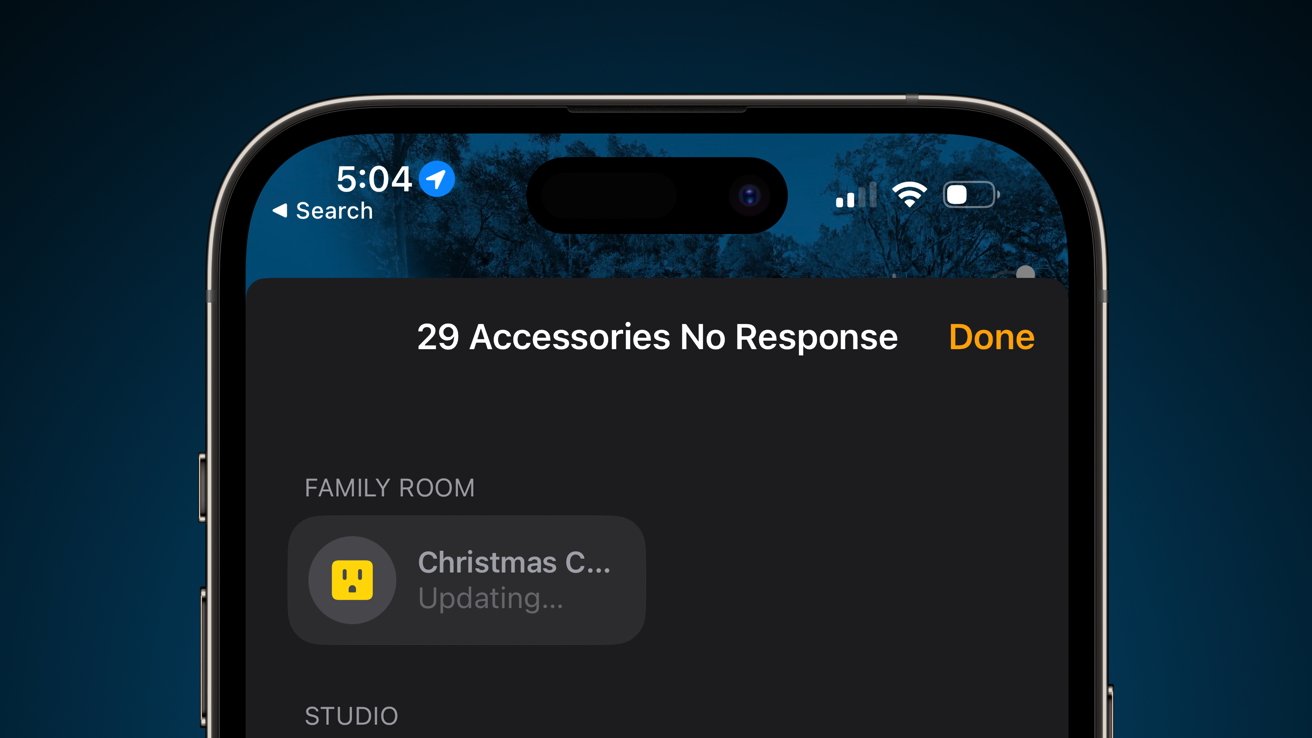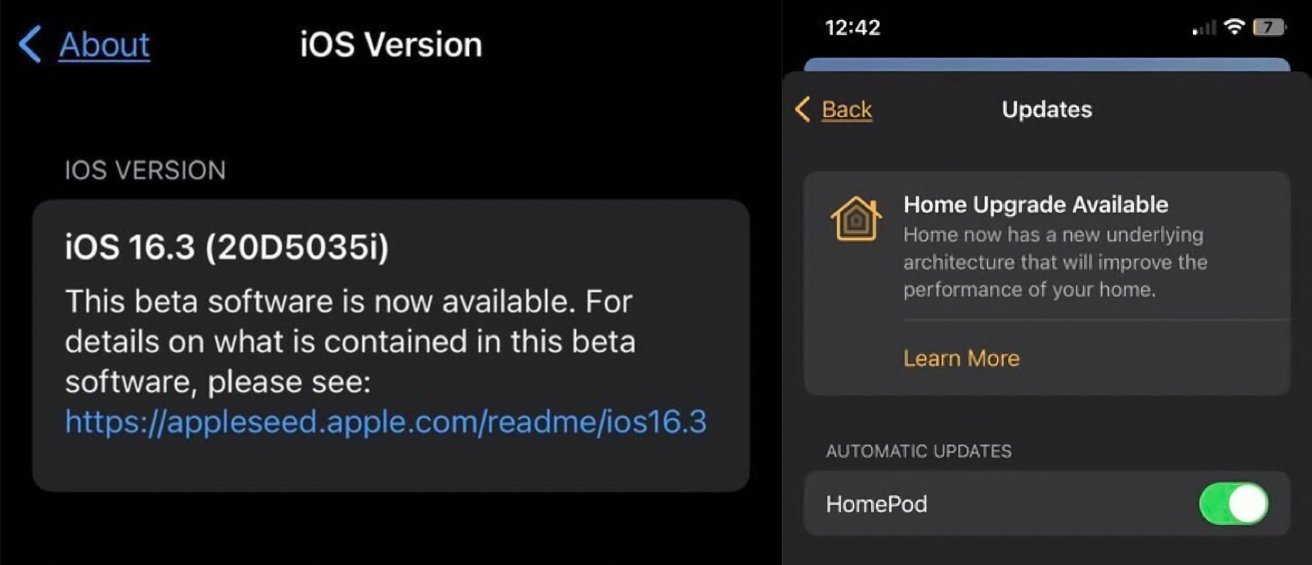Apple gearing up to re-release revamped HomeKit architecture
New unearthed code suggests that Apple will soon re-release its Homekit architecture after it initially withdrew the option in December.

Apple's December HomeKit architecture rollout
In December, Apple withdrew the option to upgrade Homekit to the new architecture, following reports the update wasn't working properly for users.
New code discovered by Twitter users nicolas09F9 and aaronp613 references the second iteration of Apple's new HomeKit architecture.
The code suggests that Apple is gearing up for the feature's eventual re-released.
The iOS 16.3 beta also showed a message referencing a "Home Upgrade Available" "new underlying architecture that will improve the performance of your home." This is the same update message that appeared in iOS 16.2 before being pulled.

Screenshots sent in by Anthony Powell
For the previous attempt, users reported seeing devices stuck in an "updating" mode after the upgrade completed, with some devices unresponsive or failing to update fully. At the time, it was unclear what had caused the problems as there weren't any commonalities between accounts of the issue.
Read on AppleInsider

Apple's December HomeKit architecture rollout
In December, Apple withdrew the option to upgrade Homekit to the new architecture, following reports the update wasn't working properly for users.
New code discovered by Twitter users nicolas09F9 and aaronp613 references the second iteration of Apple's new HomeKit architecture.
Definitely seems like it https://t.co/6ENJtP8pGJ pic.twitter.com/cFHQ7f1IZF
-- Aaron (@aaronp613)
The code suggests that Apple is gearing up for the feature's eventual re-released.
The iOS 16.3 beta also showed a message referencing a "Home Upgrade Available" "new underlying architecture that will improve the performance of your home." This is the same update message that appeared in iOS 16.2 before being pulled.

Screenshots sent in by Anthony Powell
For the previous attempt, users reported seeing devices stuck in an "updating" mode after the upgrade completed, with some devices unresponsive or failing to update fully. At the time, it was unclear what had caused the problems as there weren't any commonalities between accounts of the issue.
Read on AppleInsider

Comments
from iOS 14.7.1 to iOS 16 in preparation for buying a new phone.
It took me 2 ½ days to recover from 16.3 update. Here's what I found/discovered/stumbled across along the way:
1. If your HomePods (minis in my case) are part of a stereo group and are going to be updated, ungroup them before starting the HomePod update process.
2. Update one HomePod at a time and make sure it completes the entire process cleanly before touching other HomePods. Turn OFF automatic HomePod updates in advance in your Home app settings in-advance if you have stereo groups.
3. If your HomePod gets totally borked and never goes beyond the "Updating ..." phase (for hours):
- Plug the HomePod into your Mac using the power cable (USB-C for mini).
- After a short while the HomePod will start blinking and show up in Finder.
- Click on the device and Finder and do a Restore.
- This will download and install the latest HomePod firmware/software on the HomePod (16.3 this week). It is does not reset everything to factory defaults.
- When the process is complete you'll be prompted to disconnect it from your Mac.
- You can also reset the HomePod directly from the device, but I never had success when I tried this. If the update/download failed it may still be at the previous version, i.e., 16.2 or a beta version.
4. If you do a Restore on a HomePod, before you plug it back in, remove it from your Home app - AND remove it from the device list associated with your Apple ID. You may have to wait for the device to no longer show up in the device list. Don't worry, it will come back once the device is added back into Home (as indicated during the removal process). Don't try to reinstall the device into your Home before all references to the device are no longer shown in your iCloud devices list. In my case I had a number of aborted attempts that left copies of the devices that never finished the process in my iCloud devices list, which caused the Add Accessory process to fail miserably.
5. You will have to add the HomePod (accessory) back to your Home as if it is totally new out of the box. But before you do ...
6. Make you use the same device (iPhone or iPad) to perform all of your Accessory functions, like adding a new (or restored) accessory to your Home. This device must be at the latest iOS/iPadOS version.
7. This may be a 16.3 specific issue, but make sure you don't enable any personalized options, e.g., Siri voice recognition, providing access to your calendar, etc., during the HomePod installation process. When the Add accessory process worked as it should I was prompted post-installation to enable these features. You can also toggle these ON in the device-level settings post-installation, after the HomePod no longer reports "Updating" but shows "Not playing."
8. This may also be specific to my Home, but as a last resort I deleted my Home and created a new one with a new name. I then added one HomePod at a time back to my new home with no other bridge devices (like Apple TV) plugged in. The HomePod mini itself is a bridge and adding it to your home with no other bridges present forces the HomePod to use its bridge functionality during the installation process. Everything went smoothly when I added each HomePod to my home. When the first HomePod mini got to the "Not Playing" state I unplugged it before adding my second HomePod mini to my home. Once the second HomePod mini was at the "Not Playing" state I plugged the first one back in and it too returned to the "Not Playing" state. I then added back in my other bridge devices (Apple TVs) and everything settled out and the Temperature and Humidity readings activated after a short period of time.
If I had to guess, I think the root cause of the borkage is that the persistent configuration settings for the Home app are stored in the cloud linked to your AppleID. If something doesn't quite match between the accessory you're adding to your home and what's already in the persistent configuration settings in the cloud things go wrong very quickly. I seem to recall that I gave each of the HomePod minis in my stereo pair unique names, like "Mini 1" and "Mini 2," which became a pair that I named "Mini Pair." I suspect that when the pair was updated and given default names of 'HomePod" the Home app couldn't resolve which persistent configuration to restore into each of the HomePods when they were updated. Once I deleted the persistence data (Step 4) I left everything with default names and everything seemed to be fine. When you create a stereo pair the setup provides a way to disambiguate which one is left and which one is having the same names for both does not matter. Hopefully Apple will figure out how to handle updates without having to ungroup stereo pairs. Maybe they already have and something I did beforehand unintentionally triggered the whole mess, like renaming the HomePods.
When Apple does re-release the HomeKit update I will be waiting at least a week to update. I didn't update right away the first time and I think the update was pulled an hour after I updated. I was so close to missing out on this headache.
At the very least, Apple should allow users to create backups of their Home configuration and be able to rollback to a previous configuration that was known to be correct. Providing or exposing this detail to users may take a little of the shine off the magic, but until Apple treats user data as user currency they are jeopardizing their customers' livelihood. Time to get serious.